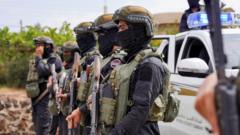What’s Behind the Cautious Calm in Southern Syria After Deadly Tribal Clashes?

A Cautious Calm in Suweida: Understanding the Aftermath of Tribal Clashes
The recent tribal clashes in Suweida, Syria, have drawn international attention as the violence subsides, leaving behind a landscape marked by loss and desperation. A report from the Syrian Observatory for Human Rights (SOHR) indicates that after a week of intense fighting between Druze fighters, Bedouin gunmen, and government forces, a "cautious calm" has returned to the city. This article delves into the events that led to this ceasefire, the humanitarian crisis that ensues, and the broader implications of the conflict in the region.
The Trigger: Abduction and Escalation of Violence
The tensions in Suweida escalated dramatically after the abduction of a Druze merchant on a road leading to the capital, Damascus. This incident ignited long-standing grievances between the Druze community and Bedouin tribes, culminating in violent clashes that resulted in over 1,000 fatalities. Both sides have been accused of committing atrocities during this tumultuous period, further exacerbating sectarian tensions.
A Ceasefire and Its Immediate Impact
On Saturday, a ceasefire was announced by Syria's interim President Ahmed al-Sharaa, aiming to quell the violence that had gripped the city. However, initial reports indicated that fighting did not cease immediately following this declaration. It was only on Sunday morning that residents began to experience a semblance of calm. The SOHR noted that the city remains under the control of local Druze fighters, while the Bedouin gunmen have reportedly withdrawn from key areas within the province.
Humanitarian Crisis: A City in Despair
As the dust settles, the humanitarian situation in Suweida has reached critical levels. The SOHR reported a severe shortage of medical supplies, with local hospitals overwhelmed and out of service. Residents have expressed dire needs for assistance, with one anonymous individual stating, "The smell of corpses is spread throughout the national hospital." The combination of casualties and a lack of medical resources has placed immense pressure on the community, highlighting the urgent need for humanitarian aid.
Government Response and Control Measures
In an effort to stabilize the region, Syrian government forces have implemented measures to contain tensions. Roads leading into Suweida have been closed off to tribal groups, with soil barriers preventing vehicle access, except for ambulances. This move aims to maintain order and prevent further outbreaks of violence, but it also restricts the flow of humanitarian aid into the city.
The Role of Local Fighters
The Druze fighters have played a crucial role in maintaining control over Suweida during this chaotic period. Their local knowledge and commitment to defending their community have been pivotal in repelling the Bedouin gunmen. However, the situation remains precarious, as the withdrawal of tribal forces does not guarantee lasting peace. The underlying issues that fueled the conflict—historical grievances and competition over resources—remain unresolved.
Looking Ahead: Prospects for Stability
While the cessation of fighting brings a temporary reprieve, the future of Suweida hangs in the balance. The ceasefire is fragile, and without addressing the root causes of the conflict, the risk of renewed violence looms large. The Syrian government must prioritize a comprehensive peace strategy, addressing the needs of both Druze and Bedouin communities to foster long-term stability.
International Response and Humanitarian Aid
The international community's response to the humanitarian crisis in Suweida will be crucial. Humanitarian organizations must mobilize resources and deliver aid to those affected by the conflict. Immediate assistance is required to address the medical shortages and provide basic necessities for the residents. Moreover, a focused diplomatic effort is needed to facilitate dialogue between the conflicting parties, paving the way for sustainable peace.
Conclusion: A Call for Unity and Understanding
The events in Suweida serve as a stark reminder of the fragility of peace in conflict-ridden regions. As the city experiences a cautious calm, it is imperative for both local leaders and the international community to work towards reconciliation and understanding. The suffering endured by the residents highlights the urgent need for compassion and support in the face of adversity. Only through dialogue and cooperation can the scars of this conflict begin to heal.
FAQs
What caused the tribal clashes in Suweida?
The clashes were triggered by the abduction of a Druze merchant, leading to escalated tensions between the Druze community and Bedouin tribes.
How many people have been affected by the conflict?
Over 1,000 people have reportedly been killed as a result of the clashes, with many more affected by the ensuing humanitarian crisis.
What measures has the government taken to restore order?
The government has closed roads leading into Suweida and deployed security forces to maintain peace, while also announcing a ceasefire to stop the violence.
What is the current humanitarian situation in Suweida?
There is a severe shortage of medical supplies and basic necessities in Suweida, placing significant strain on local hospitals and the community.
As Suweida navigates this period of cautious calm, it raises the question: how can communities rebuild trust and cooperation in the aftermath of such violence? #Suweida #SyriaConflict #HumanitarianCrisis
```Published: 2025-07-20 12:18:04 | Category: world



